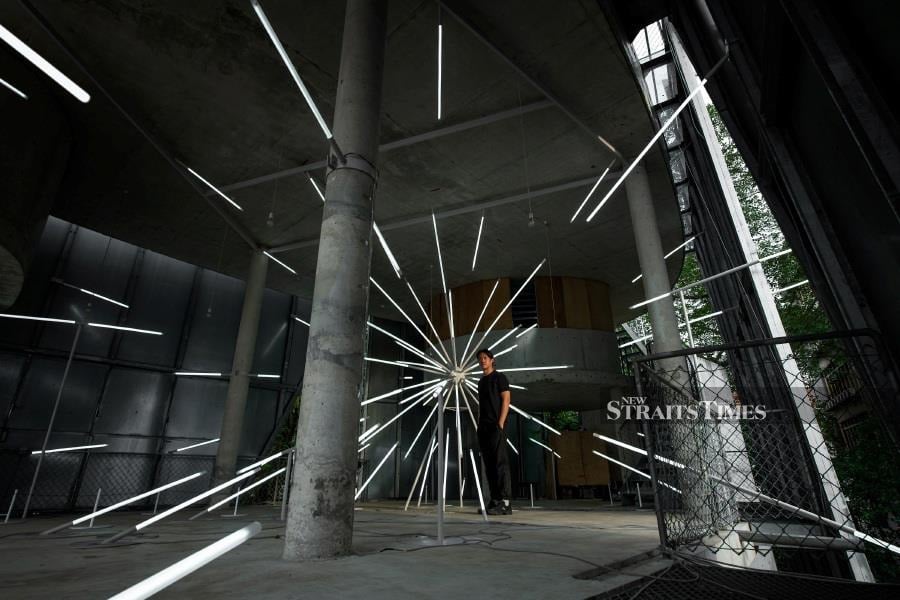"THREE…. TWO…. ONE!"
And there it was.
The LED lights flicker and blink in the dark.
If I'm expecting fireworks that night, I'm sorely disappointed.
There are no bright dazzling neon lights to impress. Where was the dazzling light show I was promised? The ones that would make me stop in my tracks?
Instead, I slap my arms feverishly. Damned mosquitoes. "Take a step back!" someone murmurs to me, as if sensing my disappointment. I grudgingly acquiesced. But then, I look up and instantly change my mind.
What I thought were shafts of light randomly placed at certain parts of the plain nondescript concrete building turned out to be part of a bigger structure that glowed incandescently from within.
It suddenly felt as though a brilliant star was about to burst out of The Godown. Mesmerised, I follow the group of people into the warehouse-like structure.
"Upstairs!" someone beckons, and we all troop in to follow him up the winding metal staircase.
The piece de resistance of The Godown is set within a darkened and stark hangar-like expanse where a ghostly burst of light with rays that seem to pierce through the concrete walls of the four-storey Air Building at The Godown, take the spotlight quite literally.
The continuously evolving shadow-play of brilliant white reflected by the diaphanous LED tubes almost makes me imagine the birth of a pulsing star. Walking by, you see things and then you also hear things — an effect both futuristic and deeply primordial.
The STAR/KL at the Godown is part of "The Light Project" (an extension of the Cultural Economy Development Agency's (Cendana) yearly marquee event, Art In The City) in collaboration with Think City, which aims to light up cities with public art and performances curated to take place nationwide in Kuala Lumpur, Penang, Ipoh, Batu Pahat, Melaka and Kuching.
The hums, banging, music and cacophony of sounds all add to the effects that a star is being birthed right in the middle of a city — certainly an unlikely place for a star to be born.
CREATING LIGHT
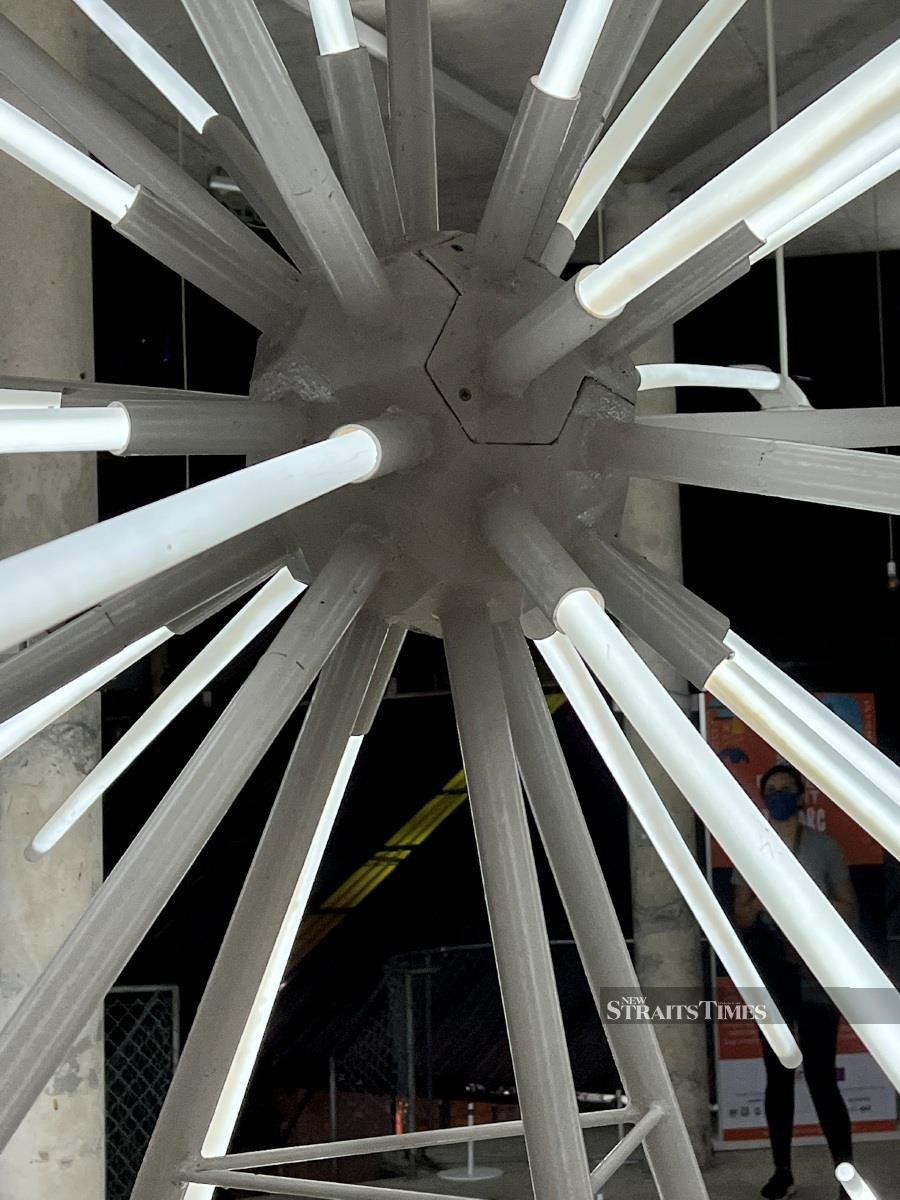
"Oh, I wouldn't call it a star. I didn't want to call it a star in the first place! It's a geometry," says artist Jun Ong blithely, adding: "I'm more interested in the mathematical aspects of the structure. In this case, it's a dodecahedron, a polyhedron with 32 facets."
"A doda-what? A poly-what?" My eyebrows shoot up and I stop taking notes.
The lanky artist shoots me a grin. "LIGHT is this thing we usually use to illuminate other things," he explains carefully, adding: "I'm interested that light has thingness itself, so it's not something that reveals something about other things you're looking at, but it becomes a revelation in itself."
In this case, Ong seems intent on revealing the deeper aspects of the mysterious star.
German astronomer Johannes Kepler once said that the structure of the solar system was determined by the testing of the five Platonic Bodies — octahedron, icosahedron, dodecahedron, tetrahedron and cube.
The nesting of these polyhedral ultimately suggests the orbital distances between planets. Materialised through the Platonic Bodies, the (truncated) icosahedron, a polyhedron with 32 facets, become the point of origin for the "star" in the three-dimensional Euclidean space.
Every star, both terrestrial and cosmic, has a core point that radiates geometry outward. The inward gravitational radiation and gas pressure of a star must equal the outward radiation and grass pressure to remain in equilibrium.
"You do know most of this is going over my head, right?" I comment dryly. Ong laughs heartily before walking closer to the pulsing "Star" creation and pointing out that each facet has one LED rod sticking out. "…and that creates the whole 'starburst' effect!"
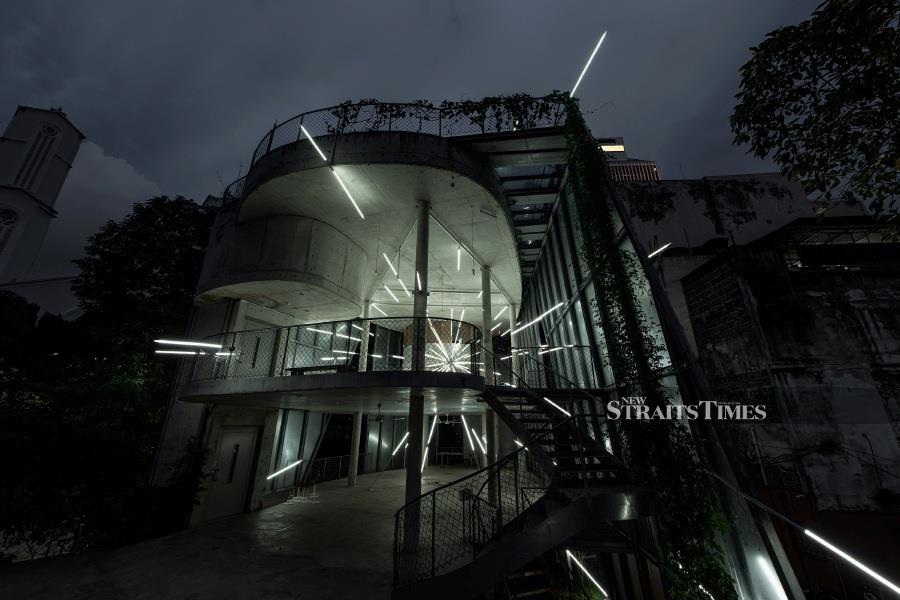
Comprising 111 individualistic "fragments" of steel, acrylic tubes and LED ropes, Ong's "star" exists as a calculated drawing in space. Akin to Italian painter Caravaggio's method of projective displacement of space using light, shadow and materiality, the star evokes multiple imagery and depth, depending on the time of day and its illumination, both natural and artificial.
But this isn't Ong's first star by any means. His first star was a jaw-dropping five-storey light installation in Penang that earned him a nomination for World's Best in Spatial Art at the Media Architecture Biennale in Sydney back in 2016.
The massive 12-faceted star, which was lodged within an incomplete concrete building structure located along Jalan Raja Uda in Butterworth, catapulted Ong to fame.

But Ong is especially proud of this slightly smaller structure here in Kuala Lumpur. "It's been a challenge to actually come up with this structure here," he admits, shaking his head slightly.
The structure in Butterworth took him six months to create and assemble, but he had only two months to come with up with the design and assemble the star in Kuala Lumpur. "Mind you, it was during the Covid-19 season so it was especially challenging!" he adds dryly.

Ong and his team couldn't drill, remove or change any aspect of the space they were given to install his vision. "We couldn't leave a single mark in this place," he shares.
Waving his hand at his star, he continues: "There's not even a single screw in this structure. Everything here is free standing. You can disassemble everything without leaving a single mark. This space became our workshop for two months. We did everything here — all the welding, all the designing, the communication — everything happened here."
This structure is a lot more intimate, points out Ong, and more "human-sized" than the one he created in Butterworth. "You can take out any one of these facets and use it at home!" he quips, grinning.
"Ah yes, it looks a lot like the fluorescent lamps I have at home," I nod in agreement, half wondering if I could get away with swiping an LED lamp from under Ong's nose.
"Oh, I love those fluorescent lamps!" he enthuses, adding: "I was inspired by those fluorescent lamps. Oh my God, your house must have one of those! It seems to be the universal language here in Malaysia!"
"Yes, it does!" I reply, confessing: "I don't particularly like it. It makes everything look too bright and sterile. I prefer the warm yellow lamps. Don't you?"
Ong laughs, before reminiscing: "My dad used to tell me, 'No warm yellow lights. You study hard. I'm getting white lights so you better study and do your Masters!'"
BEING LIGHT

His parents didn't want him to be a starving artist and insisted that he study and get a respectable profession with a guaranteed paycheck. "Asian parents!" he exclaims, shrugging his shoulders with a grin. His parents had little to do with art, confesses Ong. "My dad deals with the stockmarket while my mum's a homemaker."
Squinting his eyes, he continues: "But you know what, my 88-year-old maternal grandmother is the most creative person in the family." Pointing at his art, Ong blithely exclaims: "She gets this!"
Ong has an elder sister and a younger brother. "Ah, do you have middle child syndrome?" I tease, and he replies deadpan: "Oh yes I do, and I love it!"
He loved the arts since he was young. The young Ong spent his formative years under the tutelage of Malaysian watercolourist Lee Weng Fatt. But the cool white fluorescent tubes that his father fixed in his home continued to fascinate the young KL-born boy. "My dad used to ask me why I loved messing around with these types of lights. For me, there's so much purity and beauty in them."

Ong went on to pursue a degree in architectural studies from the University of Melbourne, Australia in 2009 and eventually earning a Master's in Architecture from the University of Westminster in England.
"Seven years of hell!" he quips. But in his graduate thesis at Westminster, he examined the notion of "drawing in space" and the sculptural form-finding techniques of Picasso and Julio Gonzalez.
The call to be an artist was strong. Ong heeded that clarion call and returned to Malaysia. "I love this country," he explains simply. "It's so easy to 'create' here!"
Since returning to Malaysia, he has exhibited his site-specific light installations at major art festivals like iLight, Singapore (2016), Live the City Festival Bangkok (2016), and Art Central Hong Kong (2018).
He has also collaborated with brands such as Nike, Adidas, Gucci, and Philips Lighting, along with institutions, including the Centre for Quantum Technologies at the National University of Singapore (NUS) and the ArtScience Museum, Singapore.
The first iteration of "Star" in Butterworth, Penang, was nominated for the World's Best in Spatial Art at the Media Architecture Biennale, Sydney, in 2016.
Ong is also the co-founder of the KL-based spatial design studio POW Ideas and a lecturer in lighting design at Sunway University, Malaysia — two roles that parallel and inform his independent art practice.
FADING LIGHT
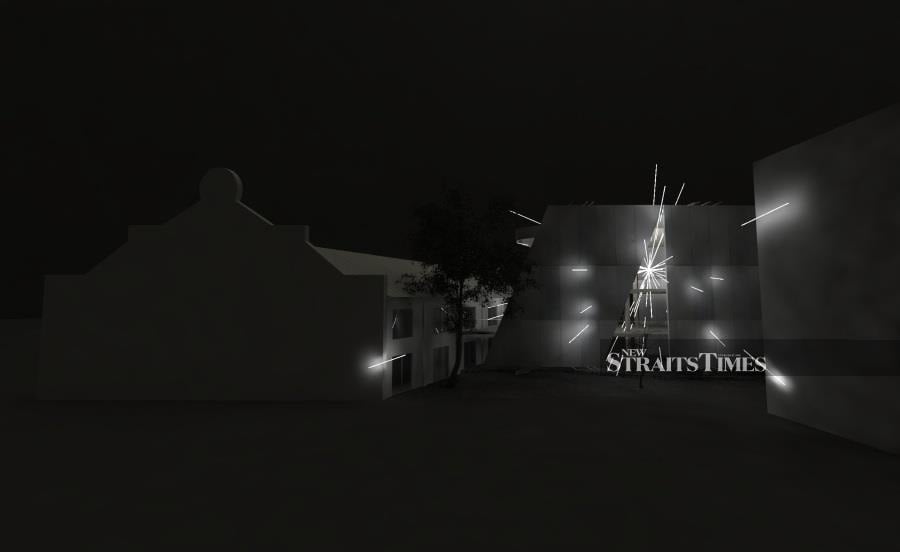
The light of the star continues to pulse. For a while, we sit in companionable silence and gaze at the brilliant structure suspended in that stark hall. The music that seems to be a weird cacophony of sounds seems to be a perfect accompaniment to the dazzling star.
"Listen," urges Ong quietly. "Can you hear that?"
The sounds, he adds, were recorded from where we were. "Can you hear the church bell? That's from the St John's Church nearby. You can hear the welding sounds when we were installing the star not too long ago. It's a composition of past, present and future overlaying itself in the music."
The composition by Reza Othman of the experimental electronic and jazz project RAO, included the sound and field recordings taken from the hustle and bustle surrounding the Godown.
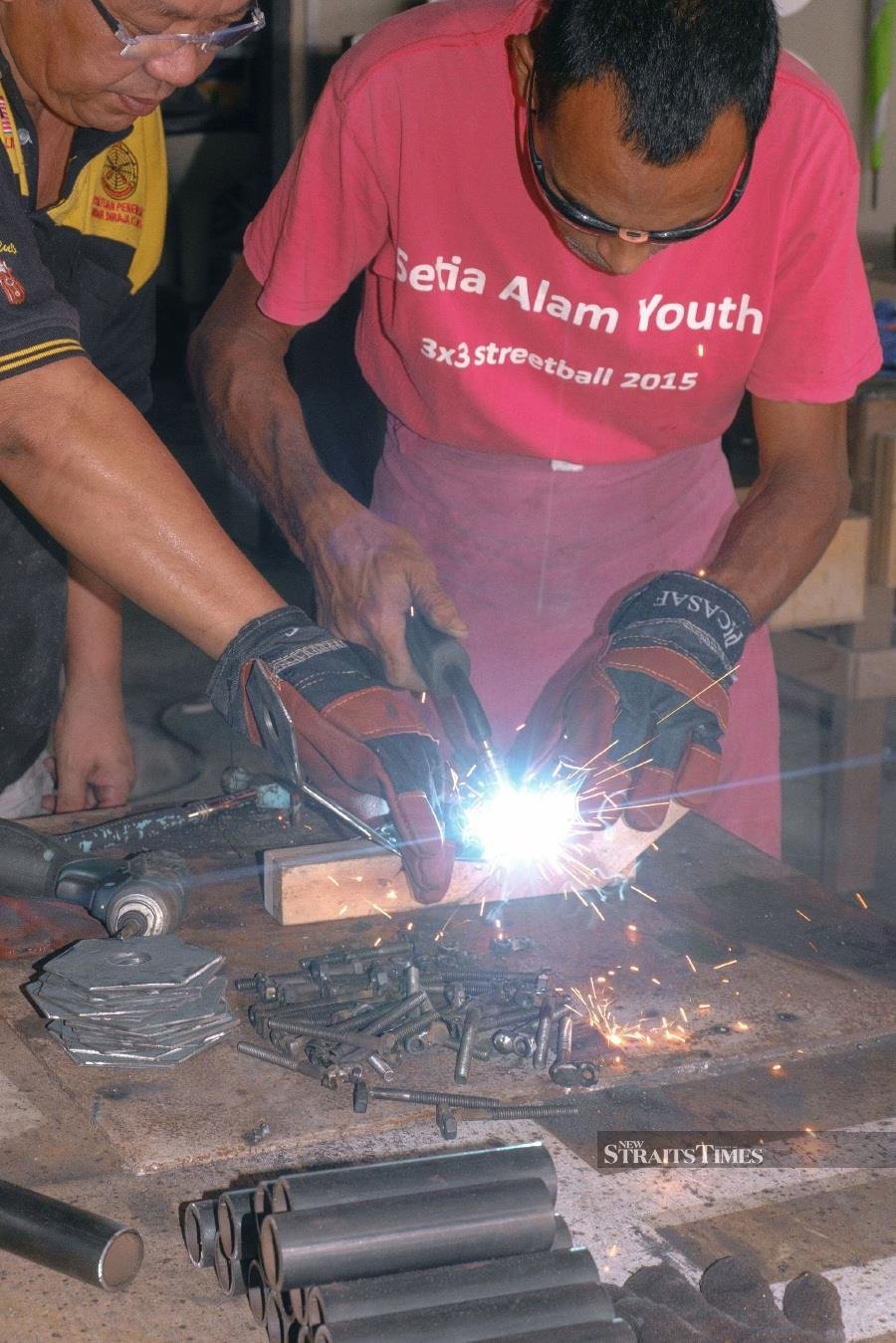
As the day wanes, a programmed light play begins, lasting until late at night. Through flickers and flashes of its light, Ong's star appears to pulse and breathe, its artificial life making up for the sun's absence through the long night.
But if you're thinking that Ong's star will be a permanent part of the KL landscape, think again. At the end of an average star's life — which spans billions of years — it either shrinks down into a white dwarf or explodes in a fantastic supernova. Ong's star will meet a less dramatic but no less thought-provoking end.
The star will last a total of 121 days and throughout that shortened lifespan, it will slowly "decay" as its light gradually dims out into non-existence. The 33-year-old artist's star will only live on as reproductions in what he describes as "hyperspace", in the reproduced images of our digital memories, where it'll continue to generate further conversations, ideas and stellar possibilities.

Ironically, it's Ong's training as an architect that led him into his pursuit of art that's deeper than what meets the eye. "I don't think I'd be able to do this if I was a fine arts artist," he admits, adding with a grin: "I suppose I have my father to thank for that!"
Ong's star may be fading as we speak, but the artist's career is set to shine a lot longer as he continues to pursues the arts with all the burning and blazing passion of a shooting star.
STAR / KL
Fission, Fusion, and Facets
Light Installation by Jun Ong
Until: March 26, 2022
Venue: The Godown, 11 Lorong Ampang 7, Kuala Lumpur
Admission is free
Follow www.instagram.com/junihaoni/, for further details and latest updates.


